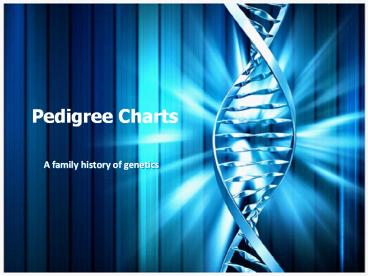Pedigree Charts PowerPoint PPT Presentation
1 / 28
Title: Pedigree Charts
1
Pedigree Charts
- A family history of genetics
2
What is a pedigree chart?
- Used to show records of families or individuals.
- Track the occurrence of diseases such as
- Huntingtons simple dominant lethal allele
causes breakdown of the brain - Cystic fibrosis 1/2500 mucus accumulates
(white North Amer.) - Tay-Sachs disease lipids accumulate in CNS
(Jewish) - Phenylketonuria missing enzyme causes problems
in CNS (Nordic/Swedish) - Shows how possible conditions may be inherited.
- Uses symbols to represent the individuals and
their relationships to each other
3
Symbols used in pedigree charts
- Normal male
- Affected male
- Normal female
- Affected female
- Marriage
4
Organising the pedigree chart
- Generations are identified by Roman numerals
5
Organising the pedigree chart
- Individuals in each generation are identified by
Arabic numerals numbered from the left - Therefore the affected individuals are II3, IV2
and IV3
6
Other Symbols Used
Dizygotic twins Two zygotes - fraternal Adopted
Monozygotic Twins One zygote - identical Consanguineous marriage people descended from the same ancestor
Sex unspecified Divorced
Number of children of each sex indicated Multiple marriage
Affected Extra marital union
7
Factors to Consider in Pedigrees
- Is the trait located on a sex chromosome or an
autosome? - Autosomal not on a sex chromosome
- Sex Linkage located on one of the sex
chromosomes - Y-linked - only males carry the trait.
- X-linked (recessive) - sons inherit the disease
from normal parents - Sons can never inherit from their father!
- How is the trait expressed?
- Dominant - the trait is expressed in every
generation. - Recessive - expression of the trait may skip
generations.
8
Reading Pedigrees
- Is the trait dominant or recessive?
- Trait skips generations
- It is recessive!
9
Reading Pedigrees
- Is the condition Sex linked or not?
- Appears in both males and females, therefore
autosomal
10
Albinism An Example
- Expressed in both sexes at approximately equal
frequency. - Thus, autosomal.
- Not expressed in every generation.
- Thus, recessive.
11
Albinism Genotype the Affected Individuals
- Assign codes for the alleles.
- Code A for the dominant normal allele.
- Code a for the recessive allele for albinism.
- Affected individuals must be homozygous for a.
- First generation parents must be Aa because
they have normal phenotypes, but affected
offspring.
12
Albinism Genotype the Normal Individuals
- Normal individuals must have at least one A.
13
Albinism Parent-Offspring Relationships
- II6 must transmit a to each offspring.
- The A in the offspring must come from the
father. - Normal father could be either heterozygous or
homozygous for an A.
14
Albinism Parental Genotypes are Known
- Both original parents are heterozygous.
- Normal offspring could have received an A from
either parent, or from both.
15
Albinism One Parental Genotype is Known
- Only the genotype of the offspring expressing
albinism are known. - Normal offspring must have received an a from
their affected father.
16
Hairy Ears An Example
- Only males are affected.
- All sons of an affected father have hairy ears.
- Sons have the same trait as their fathers
- Thus, hairy ears is Y-linked.
17
Hairy Ears Female Sex Determination
- All females are XX.
18
Hairy Ears Male Sex Determination
- All males are XY.
19
Hairy Ears Gene on the Y Chromosome
- A super-script H indicates the allele on the Y
chromosome for hairy ears.
20
Hairy Ears Wild-Type Allele for Normal Ears
- Code indicates the allele on the Y chromosome
for normal ears.
21
Hemophilia An Example
- In this pedigree, only males are affected
- Sons do not share the phenotypes of their
fathers. - Thus, hemophilia is linked to a sex
chromosomethe X. - Expression of hemophilia skips generations.
- Thus, it is recessive.
Extensive bruising of the left forearm and hand
in a patient with hemophilia.
22
Hemophilia
- All females are XX.
23
Hemophilia Expression of Male Sex Chromosomes
- All males are XY.
24
Hemophilia Genotype the Affected Individuals
- Assign codes for the alleles.
- Code H for the recessive hemophilia allele.
- Code for the wild-type normal allele.
- Affected individuals must have an H on an X
chromosome. - All daughters of affected male must carry
recessive allele
H
H
25
Hemophilia Father-Daughter Relationship
- All daughters of an affected father receive an X
chromosome with the H allele.
26
Hemophilia Genotyping the Normal Individuals
- Normal individuals must have at least one X
chromosome with the wild-type allele, .
27
Hemophilia Homozygous or Heterozygous?
- Only males affected
- Not Y-linked
- Skips a generation recessive
- X-linked
28
(No Transcript)

